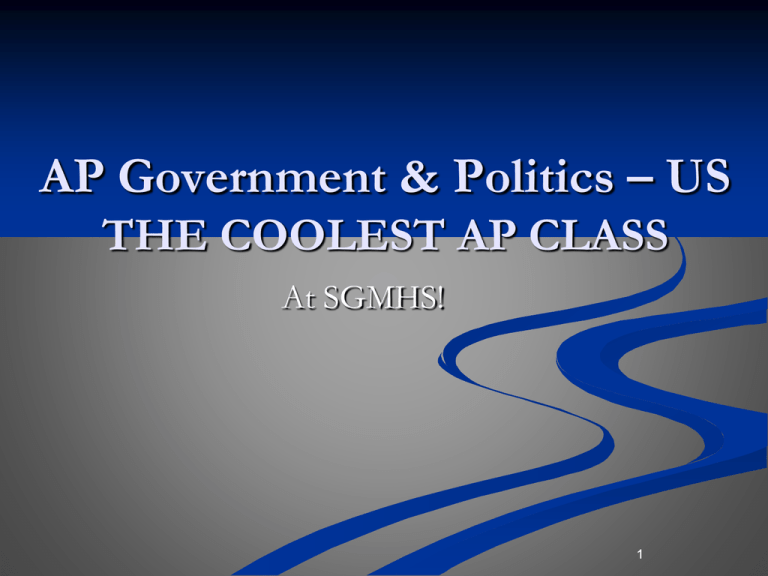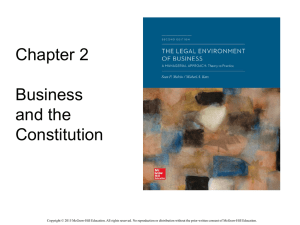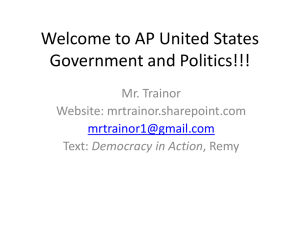
AP Government & Politics – US
THE COOLEST AP CLASS
At SGMHS!
1
Acronyms
SCOTUS
POTUS
CBO
GAO
OMB
EPA
FED
ADA
PAC
2
Answers
SCOTUS – Supreme Court of the United States
POTUS – President of the United States
CBO – Congressional Budget Office
GAO – General Accounting Office
OMB – Office of Management & Budget
EPA – Environmental Protection Agency
FED – Federal Reserve Board of Governors
ADA – American with Disabilities Act (1990)
PAC – Political Action Committee
3
2/3
Override presidential veto in both houses of
Congress
Senate approval of a treaty
Impeachment trial in the Senate
Proposal for a Constitutional Amendment in
both houses of Congress
Proposal for a Constitutional Amendment in
national convention
4
Articles of Confederation
National government could not levy taxes
No national army
No control over trade (domestic of foreign)
No federal supremacy
No Supreme Court
No Executive
Amendments required unanimous vote
Pass laws – 9/13 vote
*1781-1787 (*technically since Second Continental
Congress)
5
US Constitution
Preamble … “We the People of the United States, in
Order to form a more perfect Union…”
7 articles
Article I – Legislative, II – Executive, III – Judicial, IV –
Full faith credit, extradition, federalism, creation new states,
V – Amending, VI – Supremacy Clause, VII – Ratification
27 Amendments (Bill of Rights 1-10, ratified 1791)
1787 – Constitutional Convention
“Supreme Law of the Land” (Article VI)
Living document – read and interpreted by courts
around the world.
6
Principles of the Constitution
Checks and Balances
Separation of Powers
Federalism
Republicanism
Judicial review
Other liberties included within the articles
Writ of habeas corpus - statement of charge to “hold the body”
No bill of attainder - laws that make an individual guilty of a crime without
a trial, were barred
No ex post facto laws - which declared an action a crime after it had been
performed, were not permitted
7
Marbury v. Madison (1803)
Judicial review, executive privilege, federalism,
jurisdiction
1st time S.C. declared a Congressional act -Judiciary Act of 1789 -- unconstitutional
Chief Justice John Marshall wrote decision
Legitimized the role of the Supreme Court
Marbury v. Madison (1803)
8
Federalist No. 10
Publius (James Madison) Factions (interest
groups/parties/passions) and REPUBLICAN form of
government
Factions allow us to consider all sides; inevitable differences;
but dangerous if not monitored. Government is the mediator
between factions, none should gain enough power to violate
other’s rights in free government
“liberty is to faction what air is to fire…”
“The regulation of these various and interfering interests forms
the principal task of modern legislation…”
George Washington in his Farewell Address warned against
factions and political parties
Federalist No. 10
9
Federalist No. 51
Publius (James Madison)
Separation of branches; Checks and balances
“The great difficultly lies in this: you must first
enable the government to control the governed;
and in the next place oblige it to control itself.”
“ambition must be made to counteract
ambition”
“If men were angels, no government would be
necessary.”
Federalist No. 51
10
Federalist No. 78
Publius (Alexander Hamilton)
Judicial power implied judicial review
The independence of judges is an essential safeguard
against effects of society
(Judicial Branch) has “neither FORCE NOR WILL,
but merely judgment…”
“right of the courts to pronounce legislative acts
void…”
“No legislative act, therefore, contrary to the
constitution, can be valid.”
Federalist No. 78
11
Delegated Powers
Powers granted to one of the three
branches of the national government by
the Constitution
Enumerated – usually refers to
Congressional powers Article I, Section 8
Expressed – powers derived from the
Constitution
12
Implied Powers
Authority granted by inference of the
Constitution’s delegated powers
(I.8.18.) = Article I, section 8, clause 18
“necessary and proper clause”
McCulloch v. Maryland (1819)
Congress has the enumerated power to “declare
war” whereas the President has Commander-inChief power to command armed forces.
13
McCulloch v. Maryland (1819)
Federal supremacy (Article VI) - supremacy clause
Unanimous decision
Question over the power of Congress to establish a
national bank
Implied power - (I.8.18) Congress may “make all laws
necessary and proper for carrying into execution …and
all other powers vested in…the gov’t of the United
States ” or the elastic clause
Justice John Marshall expanded the role of the national
government
“Power to tax is the power to destroy”
McCulloch v. Maryland (1819)
14
Inherent Powers
Self-evident powers
Protection of citizens under the government
Powers which are automatic for a nation-state – foreign
negotiations, make international agreements, acquire
territory, protection of citizens, etc.
The US is a sovereign power among nations
Presidents question their inherent powers during times
of crisis and emergencies
15
Dual Federalism
Layer cake
limited powers given to the national government
(national defense and foreign policy) and the rest left
to the sovereign states
Each level dominant within its own sphere
Tenth Amendment
Conservative stance
Supreme Court is umpire
Supreme Court favored this interpretation for the first
100 years of American history
Decentralist view (states rights)
16
Cooperative Federalism
Marble cake (Morton Grodzins)
Stresses federalism as a system of intergovernmental
relations in delivering goods and serves to people
Calls for all levels of government to work together
Government is involved in a variety of issues and
programs
New Deal Programs - FDR
Liberal stance
Centralist view
17
Horizontal Federalism
State to state relations
Full Faith & Credit (IV,1) requires states to enforce
court judgments of other states (divorce) and accept public
records as valid (marriage licenses, identifications)
Interstate Privileges and Immunities (IV, 2) must
extend to citizens of other states - protection of laws, right to
engage in peaceful occupations, access to courts and freedom of
discriminatory taxes; states may not impose unreasonable
residency requirements (such as medical care or voting
requirements for new residents)
Extradition (IV, 2) states must deliver criminals back to
home state
Interstate Compacts (I, 10)
states must settle disputes
peacefully; all state to state compacts must be approved by
18
Congress
Grants
Ways that federal gov’t disperses $ to state and local
governments
“Grants-in-aid”; revenue sharing
Categorical -- formula grants, $ for a specific purposes,
subject to federal supervision (school lunches, building
of highways and airports)
Project Grants -- state, local, and nongovernmental
agencies can apply for $ (universities, employment
training programs); National Science Foundation
Block -- broad grants to states for prescribed activities
with few strings attached (child care, welfare, social
services, education and health care)
“Devolution revolution” - the effort to slow the growth
of the federal government by returning many functions
to the states (welfare) – Welfare Reform Act 199619
Mandates
Federal law for all levels of government
New Deal Programs, Great Society Programs,
Clean Air Act were mandates for the nation
Unfunded Mandates
Americans With Disabilities Act 1990 (ADA)
Unfunded Mandates Reform Act of 1995 - requires
the Congressional Budget Office (CBO) and federal
agencies to report the impact of unfunded mandates
describing the impact on state and local
governments
20
New Techniques of Federal
Control (beyond mandates)
Direct orders - criminal sanction enforced (Equal
Opportunity Employment Act of 1972)
Cross-Cutting Requirements - federal grants may
establish conditions (Civil Rights Act 1964)
Crossover Sanctions - sanctions permit the use of
federal $ in programs to influence state/local policies
(1984 act reduced fed highway $ if states didn’t increase
21 drinking age)
21
I
st
(1 )
Amendment
Civil Liberties
“Congress shall make no law respecting an establishment of
religion, or prohibiting the free exercise thereof; or abridging the
freedom of speech, or the press, or the right of the people to
peacefully to assemble, and to petition the Government for a
redress of grievances.”
Schenck v. United States (1919) speech, clear and present
danger
Gitlow v. New York (1925) incorporation of First
Amendment’s freedoms of speech and press provisions, citing
the Fourteenth Amendment’s due process clause to apply to
state law
22
I (1st) Amendment
Establishment Clause: “make no law respecting the
establishment of …”
Lemon v. Kurtzman (1971) “lemon test or 3-prong
test”
Engel v. Vitale (1962) no state-sponsored prayer in
public school
Free exercise clause “or prohibiting the free exercise
of…”
Reynolds v. United States ( 1878) – polygamy is illegal and is
not protected under 1st Amendment
Oregon v. Smith (1990) – unlawful drug use is illegal in
religious ceremonies and is not protected under 1st
Amendment
Bill of Rights Institute Religious Liberty
23
XIV
th
(14 )
Amendment - 1868
Defined citizenship
Clauses: privilege and and immunities, Due
process, equal protection
Incorporation
Application of due process clause to the State law –
“nor shall any State deprive any person of life,
liberty, or property, without the due process of the
law”
Gitlow v. New York (1925)
24
Incorporation Doctrine
The legal concept under which the Supreme
Court (and federal courts) has “nationalized”
the Bill of Rights by making most of its
provisions applicable to the states through the
Fourteenth Amendment.
The following amendments have not been
incorporated: III, VII, X (Grand Jury)
25
Selective Incorporation
Selective Incorporation – the Supreme Court (or
federal courts) decide on a case-by-case basis,
when to apply the Bill of Rights to state law
from the due process or equal protection clauses
in the Fourteenth Amendment.
Palko v. Connecticut (1937) – first rejection by
S.C. of “total” incorporation; ruled that the
Fifth Amendment double jeopardy provision
does not apply to the states through the
Fourteenth Amendment. (overturned by Benton v.
Maryland, 1969 – incorporated double jeopardy)
26
IV (Fourth) Amendment
Search and seizures
Wolf v. Colorado (1949) (incorporation
case, 4th and 14th Amendments)
Mapp v. Ohio (1961) - (incorporation case,
4th and 14th Amendment)
Exclusionary rule – anything obtained
from an illegal search cannot be used in
court
27
Due Process
5th and 14th Amendments
Protection against deprivation of life,
liberty, or property
Rights of the accused
Origin from the Magna Carta (1215)
28
V (Fifth) Amendment
Due process
Eminent domain (gov’t will pay $ for private
property)
Self-incrimination
Double jeopardy
Capital crime – Grand Jury (except Military and
emergencies)
29
VI (Sixth) Amendment
Fair and speedy trial; right to counsel
Miranda v. Arizona (1966) rights of the accused,
Fifth amendment, right to counsel, selfincrimination
Gideon v. Wainwright (1963) counsel must be
provided in felony cases (incorporation case –
due process in 6th and 14th Amendments)
30
Suffrage Amendments
XV (15) – (1870) African American males
XVII (17) – (1913) direct elections for US Senators
XIX (19) – (1920) Women Suffrage
XXIII (23) - (1961) District of Columbia
residents vote for president
XXIV (24) - (1964) prohibit poll taxes
XXVI (26) – (1971) 18 year old vote
31
Article I
Legislative Branch (Congress)
House and Senate
Very detailed powers - enumerated (I.8)
impeachment
Gives Congress the most power
“Necessary-and-proper” clause
Habeas corpus, no bill of attainder or ex post facto
laws
Interstate commerce clause
Census
32
Enumerated Powers of Congress
Levy taxes
Borrow
Regulate commerce
Naturalization and bankruptcy
Coin money
Establish a Post Office
Patents and copyrights
Create Courts
Declare war
Create army and navy
Govern the District of Columbia
33
House of Representatives
435, 2 year term, 25 years old, 7year resident, citizen
Apportionment by population for each state; Florida has *27
Congressional districts (after 2010 Census)
Districts decided by state legislatures, census of pop every 10
years
Smaller constituency, less staffers, less media, limited debate
time
All appropriation/revenue bills start in the HOUSE
Ways and Means Committee
Rules Committee (decides rules of debate)
Quorum (218)
Speaker of the House (3rd in the succession of presidency)
Policy specialists
Power to vote for impeachment (accusation)
34
Gerrymandering
Drawing of boundary lines for Congressional
districts to obtain partisan or factional
advantage
From Governor Gerry of MA in 1811, the
shape of his district looked like a salamander
Shaw v. Reno (1993) racial gerrymandering
unconstitutional, equal protection clause XIV Amendment
State Legislatures redraw districts after census
(every ten years), sometimes add or lose
Congressional districts based on their state’s
population increases or decreases
35
Senate
100 (2 per state)
Larger constituency, more staffers, more seniority,
more media, more prestige
6 year term, 30 years old, 9 years resident, citizen
Riders allowed on bills
Filibuster and cloture (3/5 of Senate)
Confirmation presidential nominations: federal judges,
ambassadors, US marshals, Supreme Court justices
Ratify treaties (2/3)
Hold impeachment trials (2/3)
36
Legislative veto
Congress invalidates Executive Branch
acts/policies
Rejection of a presidential or administrative
agency action by a vote of one of both houses
of Congress without the consent of the
president
Immigration and Naturalization Service (INS) v.
Chadha (1983) Supreme Court held that
legislative veto is unconstitutional; question over
the separation of powers
37
Bipartisan Campaign Finance Reform Act
(BCRA)
“McCain-Feingold bill” (2002)
Changed some parts in FECA 1974
$2,100 (individual) to candidate for each election
$10,000 (individual) to state party or PAC
$26,700 (individual) to national party committee
Ban on soft $ - donations to party committees for buying
equipment, remodeling headquarters, staffing regional offices, or
get-out-the-vote drives; not for a specific candidate
Definition of hard $ - financial contributions given directly to a
candidate running for office
Buckley v. Valeo (1976) individual candidate can spend unlimited
amount on self campaign
Citizens United v. Federal Elections Commission (2010)
38
Article II
Executive Powers
Vague on purpose and meaning
Commander-in-Chief (power to make war)
Make treaties
Make pardons
State of the Union Address
Appointments to the federal gov’t
http://www.articleii.org/index.html
39
Presidency
Article II
4 year term, 35 yrs old, 14 yr resident and US
natural-born citizen
XXII (22) Amendment, max 2 terms in office,
or 10 years, reaction to FDR
XII (12) changed the election process of the
president (electoral)
XXV (25) disability and succession of president
40
Formal Powers of President
*Commander in Chief
*Commission Officers (of military)
Grant pardons
State of the Union, Convene Congress
*Receive ambassadors, or other public Ministers
Wield “executive power”
“Take Care” that Laws be faithfully executed
Appoint officials (ambassadors, public ministers, SC
Justices, and all other officers)
Veto and approve legislation
*Make treaties
41
*denotes foreign powers
Informal Powers of the President
Morale builder
Party leader
Legislative leader
Coalition leader
Crisis manager
Personnel recruiter
“Leader of the Free World”
Persuader “bully pulpit” (Teddy Roosevelt)
42
Veto
President can veto and send the bill back to
Congress with the reasons why
Pocket veto -- if the President does not sign or
veto within 10 days, and Congress adjourns, the
bill is dead
bill turns into LAW – “put it in a drawer”
President neither signs or vetoes within 10 days
(Congress in session), bill becomes law.
43
War Powers Resolution of 1973
Reaction to Vietnam Conflict
Congressional act sent to Nixon, he vetoed it, sent back
to Congress, overrode veto with 2/3 vote
Presidents since Nixon have violated and have not
been punished
President can commit US forces to action only
After a declaration of war by Congress
In national emergency created by an attack on the U.S. of it
forces
President must report his action to Congress within 48 hours
and withdrawn troops within 60 days
Congress, with a concurrent resolution, can remove troops
after 90 days without a veto by President
War Powers Resolution
44
Line-item veto
Most state governors have this power
Line Item Veto Act 1996
Intent was to give President more power
over the budget
Clinton et al. v. New York et al. (1998)
decision 6-3; unconstitutional
45
impoundment
Refusal of the president to spend $
appropriated by Congress for a specific
program
Temporary delay tactic to control spending
Budget and Impoundment Control Act
(1974) reduced the President’s
impoundment powers
46
Participation in Government
Conventional - Relatively routine political behavior
that uses institutional channels and is acceptable to the
dominant culture (voting, writing elected officials,
political demonstrations - holding signs in protest,
signing a petition)
Unconventional - relatively uncommon political
behavior that challenges or defies established
institutions and dominant norms (Boston Tea Party
1773, boycotting, occupying buildings, locking arms to
block, striking, 1968 Dem Convention, assembly of a
militia group, suicide bombers)
47
docket
Supreme Court’s agenda of cases to be heard
+/- 100 granted writ of certiorari “to be informed”
2-3 are original jurisdiction
Rule of Four
stare decisis
Appellate jurisdiction
Must address a Constitutional or federal
question
48
entitlement
A claim for government funds that cannot be
abridged without violating the rights of the
claimant, for example Social Security benefits or
payments on a contract; any federal government
program that benefits to Americans who meet
requirements specified by law.
50% of our budget
49
Multimedia Resources
Apps
Pocket Justice
CRAM
Presidents
US Presidents
Constitution
FedPapers
USA Manual
Declaration
Congress
50
Multimedia Resources Continued
http://apgovmultimedia.wikispaces.com/AP+Govt+Exam+Review+R
esources
http://www.archives.gov/federal-register/electoral-college/teach.html
http://www.constitutioncenter.org/ncc_edu_Students.aspx
http://www.icivics.org/
http://bensguide.gpo.gov/9-12/index.html
http://www.articleii.org/index.html
http://www.billofrightsinstitute.org/dnn/
http://www.cspanclassroom.org/Video/621/High+School+AP+US+Government+
Exam+Review.aspx
Watch C-SPAN “Cram for the Exam” on Washington Journal the
weekend prior to the exam http://c-span.org/Series/WashingtonJournal/
51
Resources
AP Central College Board
Government & Politcs -US Home Page
Janda, Kenneth, et. al. The Challenge of
Democracy - Government in America (Eight
Edition). Houghton Mifflin, 2005.
Magleby, David B. et. al. Government By the People (21st
ed). Pearson Prentice Hall, 2006.
Wilson, James Q. and John J. DiIulio, Jr.
American Government Institutions and Policies (Ninth
Edition). Houghton Mifflin, 2004.
52
Format of Exam
50
% - 60 questions – 45
minutes
50 % - 4 Free Response
Questions – 100 minutes (25
minutes per question)
53
GOOD LUCK!
AP Government & Politics -US
EXAM
Tuesday, May 15, 2012
Relax and do your best!
Thanks for attending this review!
54









